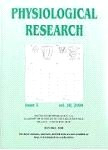Jiřičková A, Šulc J, Pohunek P, Kittnar O, Dohnalová A, Kofránek J. Physiol Res. 2009; 58(3):373–82. Epub 2008 Jul 18. IF: 1.653

Abstract:
Negative expiratory pressure (NEP) applied at the mouth during tidal expiration provides a non-invasive method for detecting expiratory flow limitation. Forty-two children were studied, i.e. 25 children with different respiratory symptoms (R) and 17 without any respiratory symptoms (NR). Children were examined without any sedation. A preset NEP of –5 cm H2O was applied; its duration did not exceed duration of tidal expiration. A significance of FL was judged by determining of a flow-limited range (in % of tidal volume). FL was found in 48 % children of R group. No patient of the NR group elicited FL (P < 0.001 R vs. NR). The frequency of upper airway collapses was higher in R group (12 children) than in NR group (5 children). In conclusion, a high frequency of tidal FL in the R group was found, while it was not present in NR group. A relatively high frequency of expiratory upper airway collapses was found in both groups, but it did not differ significantly. NEP method represents a reasonable approach for tidal flow limitation testing in non-sedated preschool children.
-mk-